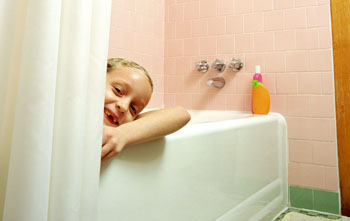Skin-Soothing Strategies for Eczema
February 2015
Skin-Soothing Strategies for Eczema
More American children are feeling the itch of eczema. One out of 10 currently suffers from this chronic skin condition. If your child is one of them, take note. That red, inflamed skin may last well into adulthood. Even so, a healthy skin strategy can help soothe your child’s symptoms.
Under the skin
Eczema isn’t simply dry skin. It actually refers to a group of skin conditions—all of which cause a rash. The most common type is called atopic dermatitis. Its telltale signs: flaky, red, itchy skin patches. The affected skin may even ooze clear fluid.
Eczema often appears in children younger than age 5. But anyone can develop it. Its exact cause is unknown. It may stem from a problem with a protein called filaggrin. This protein helps keep the skin hydrated. A lack of it may cause the symptoms of eczema to flare up.
Children tend to outgrow eczema. But that’s not always the case. In a recent study, researchers tracked the health of more than 7,100 children and teens with the skin problem. The youngsters answered questions about their symptoms every 6 months for up to 5 years. At the end of the study, many of them—some in their 20s—still reported using medicine for their eczema.
More than skin deep
You may think eczema is only a skin condition. But it can have much broader health effects, such as sleep problems. Eczema tends to itch more at night, keeping a child awake. As a result, your child may have trouble doing well at school or during other activities.
Red, irritated skin can lower a child’s self-esteem, too. That, in turn, may raise the risk for depression and anxiety. Some research also suggests children with eczema may be more prone to infections like strep throat or the flu.
The American Academy of Pediatrics recently offered the most up-to-date strategy for easing eczema. If your child has this skin condition, try these steps:
Keep your child’s skin healthy. A short, daily bath in lukewarm water and mild soap can cleanse the skin of irritants. Apply moisturizer regularly and after bathing. Whether it’s an ointment, cream, or lotion, choose a moisturizer that is fragrance free and has few preservatives.
Help your child avoid his or her triggers. They can worsen eczema symptoms. Common triggers include soaps, household cleaners, gasoline, nonbreathable fabrics, humidity, sweat, and even stress.
Apply a topical steroid during a flare-up. Some of these medicines are available over the counter, such as hydrocortisone ointment. Your child’s health care provider may prescribe more powerful drugs. Always use these as directed. They may have unwanted side effects.
Stop the itch. Itching is usually the most troubling symptom of eczema. Applying plenty of moisturizer can help. Your child’s doctor may also recommend an antihistamine.
Concerned your child has eczema? Learn more here.
Online resources
American Academy of Dermatology
National Institute of Arthritis and Musculoskeletal and Skin Diseases
Updated:
March 21, 2017
Sources:
Atopic Dermatitis: Skin-Directed Management. M.M. Tollefson, et al. Pediatrics. 2014;134(6):e1735-44., Childhood Atopic Dermatitis and Warts Are Associated with Increased Risk of Infection: A U.S. Population-Based Study. J. Silverberg and N. Silverberg. J Allergy Clin Immunol. 2014;133(4):1041-47., Eczema Prevalence in the United States: Data from the 2003 National Survey of Children’s Health. T.E. Shaw, et al. Journal of Investigative Dermatology. 2011;131(1):67-73., Health Outcomes in Atopic Dermatitis. B. Rehal and A. Armstrong. Dermatologic Clinics. 2012;30(1):73-86., Persistence of Mild to Moderate Atopic Dermatitis. J.S. Margolis, et al. JAMA Dermatology. 2014;150(6):593-600.
Reviewed By:
Turley, Ray, BSN, MSN
